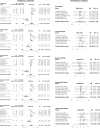Association of parental HLA-G polymorphisms with soluble HLA-G expressions and their roles on recurrent implantation failure: A systematic review and meta-analysis
- PMID: 36532068
- PMCID: PMC9751038
- DOI: 10.3389/fimmu.2022.988370
Association of parental HLA-G polymorphisms with soluble HLA-G expressions and their roles on recurrent implantation failure: A systematic review and meta-analysis
Abstract
Introduction: HLA-G plays a central role in immune tolerance at the maternal-fetal interface. The HLA-G gene is characterized by low allelic polymorphism and restricted tissue expression compared with classical HLA genes. HLA-G polymorphism is associated with HLA-G expression and linked to pregnancy complications. However, the association of parental HLA-G polymorphisms with soluble HLA-G (sHLA-G) expression and their roles in recurrent implantation failure (RIF) is unclear. The study aims to systematically review the association of HLA-G polymorphisms with RIF, the association of sHLA-G expression with RIF, and the association of HLA-G polymorphisms with sHLA-G expressions in patients attending in-vitro fertilization (IVF) treatment.
Methods: Studies that evaluated the association of HLA-G polymorphisms with RIF, the association between sHLA-G expression with RIF, and the association between HLA-G polymorphisms with sHLA-G expressions in patients attending IVF treatment were included. Meta-analysis was performed by random-effect models. Sensitivity analysis was performed by excluding one study each time. Subgroup analysis was performed based on ethnicity.
Results: HLA-G 14bp ins variant is associated with a lower expression of sHLA-G in seminal or blood plasma of couples attending IVF treatment. The maternal HLA-G*010101 and paternal HLA-G*010102 alleles are associated with RIF risk compared to other alleles. However, single maternal HLA-G 14bp ins/del polymorphism, HLA-G -725 C>G/T polymorphism, or circulating sHLA-G concentration was not significantly associated with RIF in the general population. HLA-G 14bp ins/ins homozygous genotype or ins variant was associated with a higher risk of RIF in the Caucasian population.
Discussion: Specific HLA-G alleles or HLA-G polymorphisms are associated with sHLA-G expression in couples attending IVF treatment. Several HLA-G polymorphisms may be related to RIF, considering different ethnic backgrounds. A combined genetic effect should be considered in future studies to confirm the association of HLA-G polymorphisms and sHLA-G expressions in relation to RIF.
Keywords: Human leukocyte antigen G; genetic polymorphism; immune tolerance; meta-analysis; recurrent implantation failure.
Copyright © 2022 Hu, He and Zeng.
Conflict of interest statement
The authors declare that the research was conducted in the absence of any commercial or financial relationships that could be construed as a potential conflict of interest.
Figures







Similar articles
-
Human leukocyte antigen (HLA)-G during pregnancy part II: associations between maternal and fetal HLA-G genotypes and soluble HLA-G.Hum Immunol. 2015 Apr;76(4):260-71. doi: 10.1016/j.humimm.2015.01.015. Epub 2015 Jan 28. Hum Immunol. 2015. PMID: 25637667
-
Association of Soluble HLA-G Plasma Level and HLA-G Genetic Polymorphism With Pregnancy Outcome of Patients Undergoing in vitro Fertilization Embryo Transfer.Front Immunol. 2020 Jan 14;10:2982. doi: 10.3389/fimmu.2019.02982. eCollection 2019. Front Immunol. 2020. PMID: 31993049 Free PMC article.
-
The plasma levels of soluble HLA-G molecules correlate directly with CD34+ cell concentration and HLA-G 14bp insertion/insertion polymorphism in cord blood donors.Blood Transfus. 2014 Jan;12 Suppl 1(Suppl 1):s361-6. doi: 10.2450/2012.0144-12. Epub 2013 Jan 23. Blood Transfus. 2014. PMID: 23399358 Free PMC article.
-
The HLA-G 14-bp polymorphism and recurrent implantation failure: a meta-analysis.J Assist Reprod Genet. 2017 Nov;34(11):1559-1565. doi: 10.1007/s10815-017-0994-3. Epub 2017 Jul 13. J Assist Reprod Genet. 2017. PMID: 28707147 Free PMC article. Review.
-
Meta-analysis of the relationship between 14bp insertion/deletion polymorphism of HLA-G gene and susceptibility to systemic lupus erythematosus.Hum Immunol. 2014 Dec;75(12):1171-6. doi: 10.1016/j.humimm.2014.10.008. Epub 2014 Oct 19. Hum Immunol. 2014. PMID: 25454623 Review.
Cited by
-
Bridging the divide: unveiling mutual immunological pathways of cancer and pregnancy.Inflamm Res. 2024 May;73(5):793-807. doi: 10.1007/s00011-024-01866-9. Epub 2024 Mar 16. Inflamm Res. 2024. PMID: 38492049 Review.
-
Exploring the Immunological Aspects and Treatments of Recurrent Pregnancy Loss and Recurrent Implantation Failure.Int J Mol Sci. 2025 Feb 3;26(3):1295. doi: 10.3390/ijms26031295. Int J Mol Sci. 2025. PMID: 39941063 Free PMC article. Review.
-
Ralationship between polymorphisms and diplotypes of HLA-G 3'UTR and fetuses with abnormal chromosomes or unexplained pregnancy loss (UPL).Hum Genomics. 2024 Nov 17;18(1):126. doi: 10.1186/s40246-024-00695-5. Hum Genomics. 2024. PMID: 39551809 Free PMC article.
-
HLA-G and Recurrent Pregnancy Loss.Int J Mol Sci. 2023 Jan 29;24(3):2557. doi: 10.3390/ijms24032557. Int J Mol Sci. 2023. PMID: 36768880 Free PMC article. Review.
-
Alloimmune Causes of Recurrent Pregnancy Loss: Cellular Mechanisms and Overview of Therapeutic Approaches.Medicina (Kaunas). 2024 Nov 19;60(11):1896. doi: 10.3390/medicina60111896. Medicina (Kaunas). 2024. PMID: 39597081 Free PMC article. Review.
References
-
- Ishitani A, Sageshima N, Lee N, Dorofeeva N, Hatake K, Marquardt H, et al. . Protein expression and peptide binding suggest unique and interacting functional roles for HLA-e, f, and G in maternal-placental immune recognition. J Immunol (2003) 171(3):1376–84. doi: 10.4049/jimmunol.171.3.1376 - DOI - PubMed
Publication types
MeSH terms
Substances
LinkOut - more resources
Full Text Sources
Research Materials
Miscellaneous

